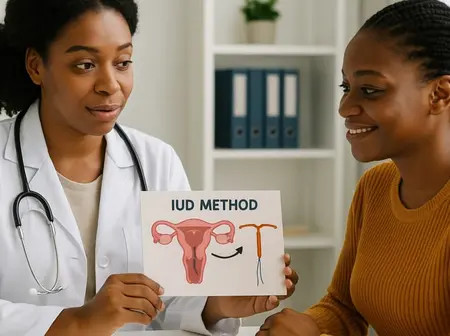At a bustling clinic in Bungoma County, 29-year-old Miriam sits quietly in the consultation room. She has two children and works as a market vendor. “I can’t afford another baby right now,” she says. “But I also fear the injection it makes me gain weight. And the pills? I forget them.”
Her nurse suggests the intrauterine device (IUD) a small, T-shaped device inserted into the womb that can prevent pregnancy for up to ten years. Miriam hesitates. “I heard it can travel to the brain,” she whispers.
This moment hope tangled with misinformation captures Kenya’s complicated relationship with one of science’s most effective contraceptives.
The science Small device, big impact
The IUD works quietly but powerfully. The copper IUD creates a toxic environment for sperm, while the hormonal IUD releases progestin to block fertilisation and thin the uterine lining. Both are more than 99% effective outperforming pills, injections, and condoms.
“From a clinical perspective, it is one of the most reliable, reversible contraceptives we have,” explains Dr. Albert Ndwiga, Head of Family Planning at Kenya’s Ministry of Health. “It requires minimal maintenance, and once inserted, women can forget about it for years.”
Globally, the IUD has transformed family planning from the U.S., where nearly 12% of women use it, to parts of Asia where uptake is even higher. Yet in sub-Saharan Africa, the picture is starkly different.
The Kenyan numbers: Uptake lags behind The Kenya Demographic and Health Survey (2022) shows 57% of married women use modern contraceptives.
Injectables (20%) and implants (19%) dominate, IUDs stand at only 4% unchanged over the past three years despite rising overall contraceptive use.
“Kenya has made remarkable progress in family planning overall, but the IUD is still neglected,” says Dr. Chimaraoke Izugbara, Director of Global Health at ICRW. “That’s a missed opportunity, especially for women who need long-term, discreet options.”
WHO Global Perspective
16% of contraceptive users worldwide rely on the IUD (WHO, 2023), In Eastern Asia, IUD use is as high as 30%, compared to 3–4% in sub-Saharan Africa.
WHO classifies IUDs as safe for most women, including adolescents and those who have not given birth.
“The IUD is one of the safest and most cost-effective contraceptives globally, yet uptake in Africa remains critically low,” WHO Family Planning Division.
In September 2024, the Ministry of Health announced that hormonal IUDs would be free in all public facilities a milestone.
Before then, hormonal IUDs were available mainly in private hospitals, costing KSh 20,000–35,000 out of reach for most Kenyan households.
“This is a game-changer,” Dr. Ndwiga affirms. “We are not only removing cost barriers, but also expanding training so every county can provide safe insertions.”
Already, early reports suggest uptake is climbing, though comprehensive national data will only emerge in future surveys.
Why it matters: Beyond family planning
The IUD’s potential reaches beyond preventing pregnancy,Maternal health Kenya records 355 maternal deaths per 100,000 live births. Reducing unintended pregnancies directly lowers these risks.
Health benefits Hormonal IUDs ease heavy menstrual bleeding, cramps, and help manage endometriosis.
Economic freedom: Women who can plan pregnancies are more likely to stay in school, join the workforce, and lift their families out of poverty.
For rural women, the convenience is crucial. “The IUD saves time and transport costs,” says Jane Achieng, a nurse in Siaya County. “Once fitted, a woman doesn’t need to return monthly. That is dignity.”
Sidebar UNFPA & FP2030 Commitments Kenya is a signatory to FP2030, pledging to expand access to modern contraceptives for all women of reproductive age.
UNFPA supplies over 40% of Kenya’s contraceptives, including IUDs, implants, and condoms FP2030 targets: Increase modern contraceptive prevalence to 64% by 2030.
UNFPA notes that for every $1 invested in modern contraceptives, $3 is saved in maternal and newborn healthcare costs.
“Investing in IUDs is investing in Kenya’s future. It prevents unintended pregnancies, reduces maternal mortality, and supports women’s rights to choice,” UNFPA Kenya Representative.
Africa’s wider struggle Across the continent, IUD uptake is similarly low. In Tanzania, only 1.3% of women use it.
Uganda hovers around 2%. Ethiopia is the exception, where aggressive training and outreach have raised usage to nearly 7%.
Experts warn that Africa’s heavy reliance on short-acting methods is unsustainable.
Discontinuation rates are high, leading to unintended pregnancies and unsafe abortions. “Long-acting reversible contraceptives like the IUD are cost-effective investments,” Dr. Izugbara notes. “They save health systems money and save women’s lives.”
Barriers in Kenya: Myths and training gaps Despite the science, myths persist.
Many women believe IUDs cause infertility, move around the body, or are “not for young women.” Some face opposition from partners or community elders.
On the provider side, gaps remain. A 2023 Nairobi study found that fewer than half of public clinics had staff adequately trained to counsel and insert IUDs. Rural areas fare worse. Supply chains, too, remain inconsistent.
The demographic dividend
Kenya’s fertility rate has dropped to 3.4 children per woman, down from nearly six in the 1990s.
Expanding access to long-acting methods like IUDs could accelerate this trend.
“When women can delay or space births, they invest more in education, health, and work,” says Dr. Esther Muia, UNFPA Reproductive Health Specialist. “That’s how a country builds its demographic dividend.”
A future of choice Back in Bungoma, Miriam eventually agrees to the hormonal IUD after a long counselling session. Three months later, she beams
“I feel free. I can focus on my children and my business.” Her story reflects a quiet revolution underway. If Kenya can overcome stigma, expand training, and ensure supply, the IUD could transform not only reproductive health, but also women’s economic futures.
As Dr. Ndwiga concludes “This is about more than family planning. It is about giving women control of their lives, and when women thrive, the whole nation thrives.”

Leave a Reply